
views
Storage

Store methanol in a metal container. Since methanol is highly flammable, you want to control static electricity. Since metal cans or drums can be grounded, they're generally the best containers. Metal cans or drums are the best containers for methanol because they can be grounded. Plastic can't be grounded, so don't use containers like you would for gasoline. If you have several containers, wrap them together with metal cables or wires to bond them so that they're all grounded. Some containers come with bond wire to use for this purpose. When filling or dispensing methanol, ground the equipment you use to transfer the methanol together with the holding containers. Use metal wire to attach the equipment to an object that's already grounded, such as a metal pipe or metal building framework.

Keep containers closed and sealed. Sealed containers keep fumes from leaking out and also prevent the stored methanol from absorbing moisture in the air. For safety, the container should be capable of holding at least 110% of the current volume to account for potential thermal expansion. Otherwise, the container could rupture. If you frequently open the containers, make sure you have lids that can be repeatedly resealed after opening.
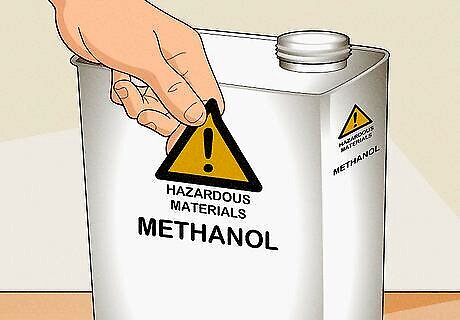
Label containers clearly. Include hazardous material warning labels on all sides of the container along with the word "METHANOL." Add icons on all sides indicating that the material inside the container is flammable and toxic. The specific labels you might need depend on federal and state regulations. If you're not sure, speak to someone who has experience in the regulation and management of hazardous materials or contact your local environmental office.
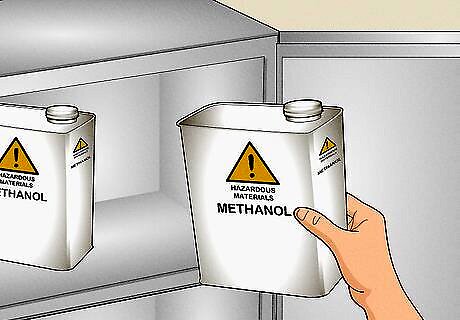
Keep small quantities in a fire-proof metal cabinet. If you're not storing several large drums of methanol, you can normally keep it in a fire-proof chemical cabinet. Make sure the cabinet is well-ventilated and situated in a cool, climate-controlled area, such as a laboratory storage room. Ground the cabinet as well as all the containers inside it. If there are electrical or electronic components in the same room as the cabinet, enclose them to avoid the risk of accidental ignition.

Maintain a dedicated storage facility for larger quantities. If you're keeping several large drums or tanks, store them in a well-ventilated location surrounded on all sides by a concrete berm or curb. Make sure the storage area is well-ventilated and equip it with vapor and heat detectors. Don't store methanol with any other chemicals and protect it from heat and ignition sources. If there is electricity running to the area, make sure it's fully enclosed. Place signs on all sides and at the entrance to the facility to alert people that hazardous materials are being stored there.
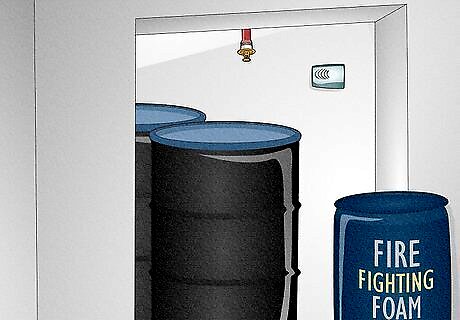
Provide effective protective measures to combat an emergency. In the event of spillage, exposure, or ignition of the methanol you have stored, time is of the essence to get the spill contained or to put out the fire. You may not have enough time to wait for first responders to get there. Keep at least the following on hand: Carbon monoxide and carbon dioxide detectors Infrared combustion detectors Fine water mist spray sprinklers Alcohol resistant fire-fighting foam Eye wash and shower stations in case of accidental exposure
Disposal

Use personal protective equipment (PPE) when handling methanol. Wear nitrile gloves, safety goggles, and a respirator mask at all times while in the presence of methanol. If you get any methanol on your gloves, change them immediately. Use a lab coat or other protective hazardous waste suit to protect your clothing. If you get any methanol on your clothing, remove it immediately and treat it as hazardous waste — don't wash it or rinse it with water.
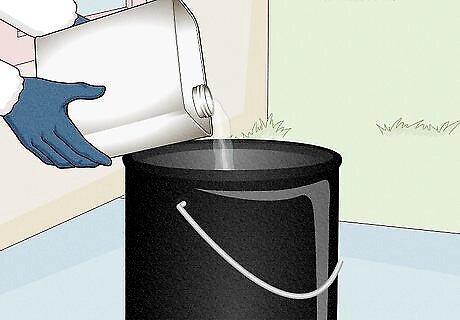
Put waste methanol in a metal container. Use the same type of container you would use for good methanol. Even waste methanol is still highly flammable, so ground the containers to reduce the risk of accidental ignition from static electricity. When the container is full (not completely full — leave room for thermal expansion), close the lid and seal it properly so that no fumes can escape. Keep your waste containers separate from the rest of your methanol, preferably outside, until they can be taken to the proper disposal facility.
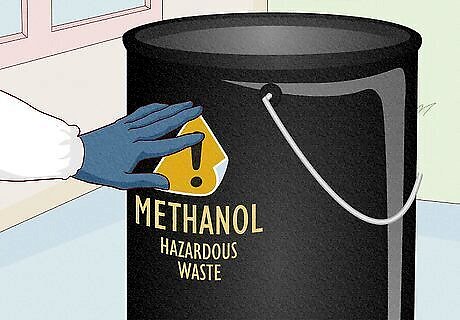
Label the containers as hazardous waste. Write the words "METHANOL — HAZARDOUS WASTE" clearly on all sides of the container. Add "flammable" and "toxic" to designate the specific hazards associated with methanol. If you have stickers or labels with hazardous waste symbols, affix these as well. On the top of the container, write the date you filled the container.

Dispose of empty containers the same way you dispose of methanol. Because empty containers likely contain methanol residue, treat them exactly the same as you would the methanol itself. Use the same hazardous materials procedures rather than simply throwing them away in the regular trash. Likewise, if you spill methanol on gloves or clothing, those items should also be disposed of as though they are hazardous materials.

Contact your local environmental office for help with large quantities. Your city or county public works department can tell you how to arrange for disposal of small quantities of waste methanol. For larger quantities, you typically would need to enter a contract with a commercial hazardous waste disposal facility. Methanol can be recycled by distilling it. Search online for nearby methanol distillation centers. Some universities have these on campus.




















Comments
0 comment